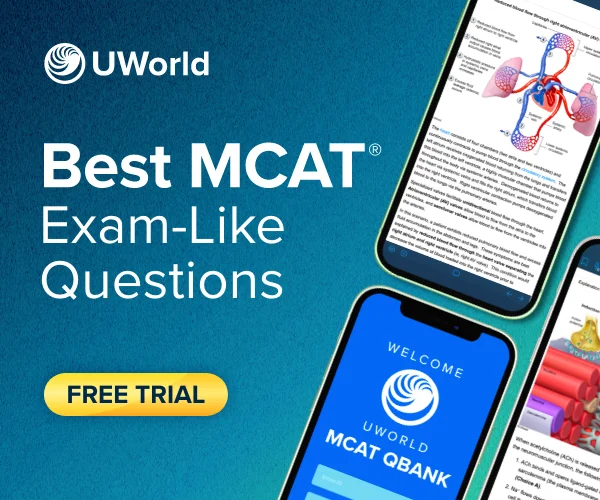Active learning is a research-backed methodology that activates deeper cognitive processes through interactivity, strengthening your ability to recall information. Instead of passively reading a book or sitting through a classroom lecture, you’ll engage with the content you’re reviewing.
This comprehensive approach ensures a thorough grasp of concepts, leading to better retention and higher exam scores.
Active Learning Methodology: What You Need to Know
For pre-med students studying on a time crunch, MCAT® prep incorporating an active learning methodology can be a game-changer.
Research has consistently shown that active learning strategies improve educational outcomes compared to traditional lecture-based methods. In a study analysis by the scientific journal PNAS, students who implement active learning score around 6% higher on their exams.
How Active Learning Boosts MCAT Performance
The active learning method enables you to apply practical knowledge effectively on your exams — and in your future medical career. Here’s how active learning can help you boost your MCAT performance:
Enhance Your Review with Our MCAT Active Learning Tools
Our MCAT Comprehensive Prep Course integrates active learning strategies in our interactive MCAT Prep Books (UBooks), Videos, Flashcard Quizzes and student-loved QBank. Here’s how we incorporate this methodology into our prep materials to make your study experience effective and engaging:
10% of What You Read
Our expertly written UBooks are organized into units, chapters, lessons, and concepts to make them easy for you to use. We equip you with 6 comprehensive science review books and 2 CARS practice books that include print and digital formats.
20% of What You Hear
Our Comprehensive Prep Course is designed to reinforce what you've learned in the classroom through content review and practice. Interactive review keeps you engaged and exam-like questions mimic the actual MCAT format and feature detailed answer explanations to help you understand the reasoning behind every choice and solidify your grasp of key concepts.
30% of What You See
Our UBooks are packed with vivid illustrations and interactive elements that simplify MCAT topics so you can easily retain them. Each UBook features 4,000+ educational images and hundreds of high-impact hyperlinks, bringing scientific concepts to life. Other interactive features in our UBooks that are perfect for visual learners include:
- Illustrated MCAT Prep Books and QBank: Enjoy a highly visual review experience with heavily illustrated prep books and QBank question explanations.
- Realistic Scenarios: Understand challenging MCAT concepts with images that bring scientific concepts to life.
- Bolded Key Terms: Easily grasp fundamental concepts with bolded and clearly defined keywords.
- UBook Lab: Explore detailed descriptions and visual depictions of essential MCAT laboratory techniques.
- Step-by-Step Calculations: Learn how to tackle tough math problems with worked-out examples across MCAT subjects.
- Concept Check Questions: Test your knowledge with 450 concept check questions in Biology, Biochemistry, General Chemistry, Organic Chemistry, and Physics.
- Statistics and Research Design: Master the introductory concepts necessary for basic statistics tested on the exam.
- UBook Connections: Discover important references within and across UBooks to gain the context you need to make connections.
- High-Yield Video Lessons: Retain more with our short video lessons that illustrate science concepts in a way that’s easy to understand.
50% of What You See and Hear
Our targeted video lessons are taught by experts with advanced degrees and simplify key science concepts in a step-by-step manner within the UBooks interface. This streamlined study experience ensures that you stay engaged as you complete your content review.
70% of What You Say and Write
Active participation through discussions, note-taking, and flashcard creation significantly boosts retention. Use our digital notebook and spaced repetition flashcards while reading a chapter or completing a question set for optimal learning. Engaging with these data-driven study tools helps reinforce the material.
90% of What You Do
Customize practice tests from our QBank content and use timed mode to simulate the exam environment. By reviewing under exam-like conditions, you become more familiar with the format and timing, reducing anxiety and improving performance.
Frequently Asked Questions
What's the best way to learn MCAT content?
Do UWorld flashcards promote MCAT active learning?
What is the biggest myth about active learning?
- Enhanced scores
- Better retention
- Increased motivation
Can I pass the MCAT exam using the active learning method?
Are UWorld’s MCAT active learning tools included in the prep course?
Explore More MCAT UWorld Resources
Try a free MCAT sample question from each subject. Our MCAT QBank provides extensive practice with both passage-based and discrete questions, mirroring the exam's format to boost your test-taking skills.
Preview our MCAT videos which include visual step-by-step animations that simplify complex concepts in just 3 to 6 minutes. Seamlessly integrated with our MCAT prep books, our videos offer a streamlined, and engaging study experience.
Improve retention by identifying knowledge gaps with MCAT spaced-repetition flashcards. Study difficult concepts more often until you master them, adapting to your study progress and driving active learning.
My Notebook, a personalized digital notebook, helps you organize content and browse key concepts in less time. Boost your study performance and enhance MCAT learning to succeed on exam day!
Take your MCAT prep on the go using our mobile app. Get complete access to your UWorld MCAT active learning tools and enjoy seamless study sessions across all devices, no matter where you are.
References and Supporting Research
Cavenagh, S. (2016). The spark of learning: Energizing the college classroom with the science of emotion. Morgantown, WV: West Virginia Press.
Freeman, S., Eddy, S.L., McDonough, M., Smith, M.K., Okoroafor, N., Jordt, H., & Wenderoth, M.P. (2014). Active learning increases student performance in science, engineering, and mathematics. Proceedings of the National Academy of Sciences 111 (23) 8410-8415.
Henning, J.A., Ballen, C. J., Molina, S. A., Cotner, S. (2019). Hidden identities shape student perceptions of active learning environments. Frontiers in Education 4, 129.
Kuh, G., O’Donnell, K., & Schneider, C. (2017). HIPs at ten. Change, 49(5), 8-16.
Harvard University Bok Center for Teaching and Learning. (n.d.). Active learning.
University of Michigan Center for Research on Learning and Teaching. (n.d.). Introduction to active learning.
Smart Sparrow. (n.d.). What is active learning?.
Cornell University Center for Teaching Innovation. (n.d.). Active learning.
Harvard Gazette. (2019, September 4). Study shows that students learn more when taking part in classrooms that employ active learning strategies.
Freeman, S., Eddy, S. L., McDonough, M., Smith, M. K., Okoroafor, N., Jordt, H., & Wenderoth, M. P. (2014). Active learning increases student performance in science, engineering, and mathematics. Proceedings of the National Academy of Sciences, 111(23), 8410-8415.
UK Rothe. (n.d.). Active methodologies for learning.









